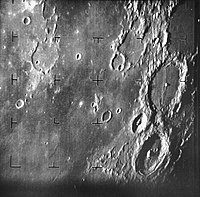 Block III Ranger spacecraft | |
| Manufacturer | Jet Propulsion Laboratory |
|---|---|
| Country of origin | United States |
| Operator | NASA |
| Specifications | |
| Bus | Block I, Block II, Block III |
| Production | |
| Status | Retired |
| Launched | 9 |
| Failed | 5 |
| Maiden launch | August 23, 1961 |
| Last launch | March 21, 1965 |
| Related spacecraft | |
| Derivatives | Mariner |
| Configuration | |
 Block II Ranger spacecraft | |

The Ranger program was a series of uncrewed space missions by the United States in the 1960s whose objective was to obtain the first close-up images of the surface of the Moon. The Ranger spacecraft were designed to take images of the lunar surface, transmitting those images to Earth until the spacecraft were destroyed upon impact. A series of mishaps, however, led to the failure of the first six flights. At one point, the program was called "shoot and hope".[1] Congress launched an investigation into "problems of management" at NASA Headquarters and Jet Propulsion Laboratory.[2] After two reorganizations of the agencies,[citation needed] Ranger 7 successfully returned images in July 1964, followed by two more successful missions.
Ranger was originally designed, beginning in 1959, in three distinct phases, called "blocks". Each block had different mission objectives and progressively more advanced system design. The JPL mission designers planned multiple launches in each block, to maximize the engineering experience and scientific value of the mission and to assure at least one successful flight. Total research, development, launch, and support costs for the Ranger series of spacecraft (Rangers 1 through 9) was approximately $170 million (equivalent to $1.25 billion in 2023).[3]
- ^ Cortright Oral History (p25)
- ^ Dick, Steven J. "NASA's First 50 Years: Historical Perspectives" (PDF). history.nasa.gov. NASA. p. 12. Retrieved 17 June 2019.
- ^ Johnston, Louis; Williamson, Samuel H. (2023). "What Was the U.S. GDP Then?". MeasuringWorth. Retrieved November 30, 2023. United States Gross Domestic Product deflator figures follow the MeasuringWorth series.